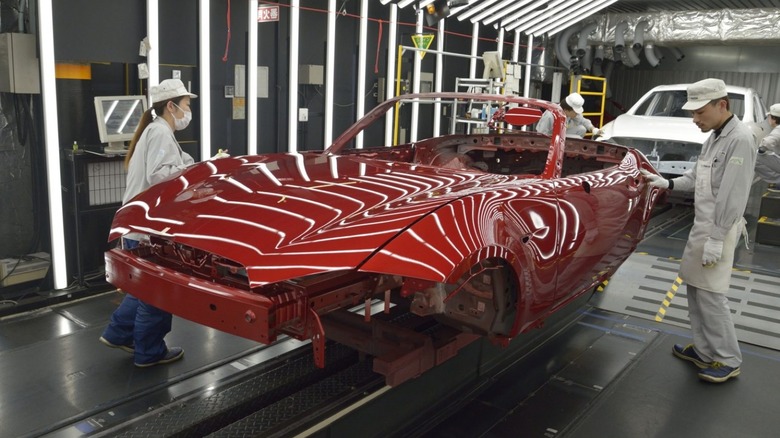There's A Reason Mazda's Red Paint Is Famous – And It's Not Just How It Looks
It's easy to spot a Mazda long before you've gotten close enough to check out the logo or detailing. That is, it's easy if it's finished in the company's signature Soul Red Crystal: a reflective, multi-layered coating crafted with bright pigments, tiny aluminum fragments, and light-absorbing flakes. Although the color is eye-catching courtesy of its reflective shimmer and depth, that's not the main reason why it's so well known. It's actually mostly because of the specialist and exclusive way the paint is applied and designed.
Mazda developed a special approach for painting production models known as Takuminuri. The phrase is a portmanteau of "master craftsman" or "artisan" (takumi) and "paint" or "lacquer" (nuri), meaning "artisan coloring". The automaker programmed its painting robots — which are commonly used for coating mass-produced vehicles — to simulate the way that Mazda's artisans paint their concept cars by hand. This allowed even their commercially available cars to achieve that identifiable look that was previously reserved only for select models.
Soul Red Crystal is actually made up of three layers of coating on top of the base primer, each with their own purpose. The base layer is a reflective or absorptive layer, which is made up of a mixture of two kinds of flakes. One kind is light-absorbing, while the other is high-brightness, microscopic flecks of aluminum, chosen to reflect the light. A translucent layer of high-chroma pigment sits on top, giving a vibrant red appearance, before being finished off with a clear top coat for gloss and shine. These layers allow the light to effectively bounce around before reflecting it back to you, creating that recognizable signature glow.
Inside the Takuminuri approach
Mazda's specialized paint technology was first used back in 2012, with the launch of Soul Red Premium and Soul Red Metallic. From there, the Takuminuri method was revised and refined through different iterations, including the 2016 Machine Grey. The company has gone as far as saying that developing this practice was fundamental to developing their iconic red paint, kudos to the way it allows light to skitter across a car's surface. In fact, Takuminuri painting was designed to fit into Mazda's identifiable Kodo design language. This philosophy centers three principles: Yohaku, Sori, and Utsuroi. Utsuroi focuses on light and shade — a fitting principle for a finish with the main purpose of creating a highly reflective, shining effect through a trick of the light.
Mazda now has four different Takuminuri paints available to choose from; two premium shades called Artisan Red and Rhodium White, alongside the aforementioned Soul Red Crystal and Machine Grey. Each color follows a similar process to create a multilayered, reflective finish. They're also all complete with tiny fragments of metal flakes that are just a few microns in size to create that identifiable Mazda shimmer. Adding these high-brightness flakes helped Mazda avoid adding a fourth paint layer, in turn evading any associated environmental consequences, while still increasing the paint's saturation and depth by 20% and 50% respectively. This sets the Takuminuri approach apart from other manufacturers' metallic finishes, which tend to use larger metal fragments to produce the effect and fewer layers of paint.
Soul Red Crystal isn't the start of Mazda's relationship with red
Mazda's heavy use of the color red didn't start with Soul Red Crystal. It actually goes back much further, all the way to the company's first passenger car. The 1960 R360 Coupe, a now-classic kei car, came in three different colors, with one of them being a glossy red named Maroon Rouge. You could even choose to get the car's interior decked out in red. Similar to the motivation behind developing the Takuminuri painting method, the car was intended to be an affordable but striking option for consumers.
Over the years, other popular red finishes emerged throughout Mazda's range. Classic Red, Vintage Red, and Sunrise Red are just a few examples that rolled onto the market throughout the 20th century, and later, shades like Soul Red Premium and Metallic. In turn, the brand's identity became almost synonymous with bright, shining red paint. According to Keiichi Okamoto, Senior Creative Expert in Mazda's Design Division, this led the automaker to develop its own special red, and so, Takuminuri was born.
Mazda, which is headquartered in Fuchū, Hiroshima, also traces its signature red back to the color's significance and meaning in wider Japanese culture. A bright red is used to reflect the national flag's crimson 'Hinomaru' sun. Much like in other cultures, the shade is also used to denote passion and strength. Mazda regularly notes the influence that Japanese art and culture has on its creations and color choices, alongside its wider Kodo design ethos, with the company's signature red being no exception.


